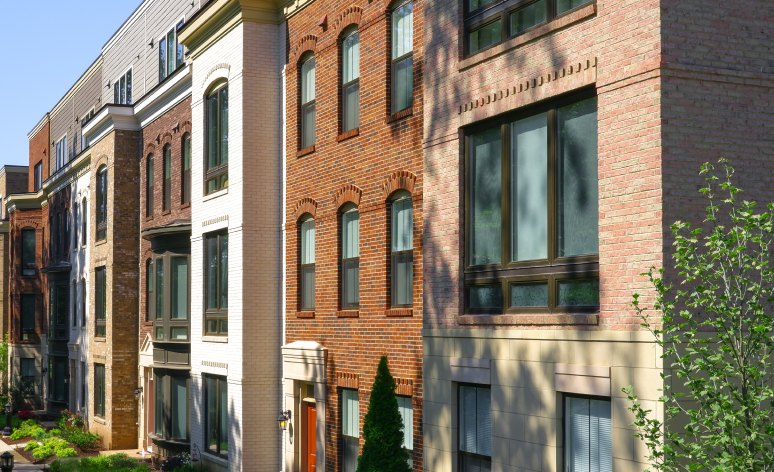
Help stabilize workforce housing communities via beneficial private financing
Sponsor-Dedicated Workforce (SDW) is a creative financing solution that increases the supply of affordable housing available to workforce renters in urban and rural communities by offering borrowers competitive pricing and underwriting flexibility. It provides incentives for borrowers of conventional properties that establish rent restrictions as part of a private financing approach to address the affordability crisis for the missing-middle renter. Borrowers that create or preserve rents, on a minimum of 20% of the units, affordable to renters earning up to 80% Area Median Income (AMI) or, in certain metros, up to 100-120% AMI can leverage SDW.
Who are workforce renters?
In many communities across the country, it can be difficult for middle-income households to rent housing in the areas in which they work. This is in part due to rent growth outpacing wage growth for decades1, and a limited supply of housing affordable to these workers who rarely qualify for housing subsidies. Workforce housing is often seen as affordable to households earning between 80-120% of AMI, specifically targeting middle-income workers living in a particular geography.
Reversing Housing Trends in the United States
Sponsor-Dedicated Workforce financing is a critical tool for expanding affordable housing options for workforce renters across America including many rural communities which lack sufficient rental options, with a significant portion of the housing stock built before 1960. This importance is underscored by several trends in housing:
- Rising rents outpace income growth.
- Rents have risen by an average of 38%1 over the past decade, outpacing wage growth and making it difficult for workforce renters to find affordable housing.1
- Between 2000 and 2023, real rents in rural areas rose by 31.2%, while median real income for rural renters increased by only 5.5%, creating a significant affordability gap.2
- Nationwide shortage of supply. There is a nationwide shortage of 1.5 million+ homes2, further limiting their options. 3
- Cost burdens are widespread among rural renters. As of 2023, 47% of rural renter households were cost burdened, spending more than 30% of their income on housing. Nearly half of these households faced severe burdens, spending over 50% of their income on rent.4
- Growing strain on Middle-income rural renters. Even rural households earning between $45,000 and $74,999, the cost burden rate exceeded 40%, reflecting a growing strain on traditionally stable income groups.5
- Homeownership is slipping out of reach for rural families. Real house prices in rural areas have risen by 75.5% since 2000, while incomes have lagged. This has led to a decline in homeownership rates among working-age rural Americans.6
How to get started
Create and preserve workforce housing with a product initiative that offers flexible loan terms and competitive pricing.
Financing with minimal documentation and no third-party compliance
Annual Compliance
- The Servicer manages the affordability requirements, including verification of the SDW rent restrictions.
- The Borrower must annually submit a certification of compliance via the Supplemental Annual Loan Agreement Certification (Form 6620.Supplemental.SDW) and rent rolls to the Servicer.
Loan Documents
- Modifications to Loan Agreement (Sponsor-Dedicated Workforce Housing) (Form 6271.SDW); and
- Modifications to Security Agreement (Sponsor-Dedicated Workforce Housing) (Form 6325)
SDW offers conventional properties distinct benefits
- Lower interest rates and competitive pricing
- Flexible loan terms, with simple loan document modifications
- Straightforward annual rent monitoring process with no third-party compliance requirement
- Creation and preservation of workforce housing affordable to households earning up to 80% of Area Median Income or, in certain metros, up to 100% – 120% of AMI
- Supports socially responsible conventional borrowers with the opportunity to create or preserve ongoing affordability for renters
- Can be combined with other products such as Green Financing, Expanded Housing Choice (EHC), Special Public Purpose (SPP), Near-Stab, and other specialty loan products
Eligibility
SDW provides a creative solution for borrowers. Requirements to consider:
- Existing stabilized conventional properties
- Borrower must commit to holding a minimum of 20% of unit rents restricted up to 80% AMI, or up to 100-120% AMI in cost burdened markets
- Rent restrictions must be in place for the life of the loan term
- Rent affordability levels are identified and in place by the Mortgage Loan Origination Date
- Property must be compliant with rent affordability levels within 12 months of the Mortgage Loan Origination Date
SDW deal spotlight
Why Fannie Mae?
Fannie Mae offers expertise and certainty in complex transactions. With a delegated risk-sharing model, DUS leverages private capital, aligns interests through risk-sharing, and supports life-of-loan servicing.
Learn more
Sources:
1 Source: Fannie Mae Economic & Strategic Research Group estimate
2 Source: U.S. Department of Housing and Urban Development, Rural Housing Trends Report, 2023
3 Source: Moody’s The Outlook for the Housing Market, Feb. 2023
4 Source: Joint Center for Housing Studies of Harvard University, The State of the Nation’s Housing 2023
5 Source: National Low Income Housing Coalition, Rural Rental Housing Affordability Report, 2023
6 Source: Federal Reserve Bank of St. Louis, Rural Housing Market Analysis, 2023


